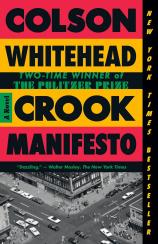Crook Manifesto
Review
Crook Manifesto
Colson Whitehead’s 2021 novel, HARLEM SHUFFLE, was set in the 1960s and introduced readers to Ray Carney, a Black family man and aspiring business owner trying (and failing) to overcome the criminal past he inherited from his small-time crook father. The newly released sequel, CROOK MANIFESTO, is divided into three parts, each of which is set in a different year in the 1970s (a planned follow-up, taking place in the 1980s, will round out the trilogy).
When readers become reacquainted with Carney, it’s 1971, and New York City is in the midst of a wave of crime and unrest. Carney has gone straight, determined to focus his attention on his young family (who have settled into their townhouse on so-called Strivers' Row) and his legitimate furniture business. He’s no longer fencing stolen goods --- that is, until a figure from his past, the notoriously crooked white cop Munson, offers him a job offloading jewelry in exchange for the Jackson 5 tickets that Carney’s daughter desperately wants. Munson is embroiled in a controversial case involving the Black Liberation Army, an offshoot of the Black Panthers.
"Colson Whitehead might be a literary chameleon, eager to try his hand at a variety of genres and modes, but his writerly perceptiveness and stylistic talents shine through."
What follows is a spectacularly tangled series of heists, orchestrated by Munson as his last hurrah before fleeing the country. The adrenaline rush and violence that ensues reminds Carney of everything he both loved and loathed about that crooked life.
The novel’s middle section, set in 1973, finds Carney playing a minor role, as the focus is on his former associate, the photographer and arsonist Zippo, who has reinvented himself as a filmmaker intent on making a Blaxploitation movie “filmed entirely on location in Harlem USA.” His production is derailed when his leading lady goes missing, and Carney’s family friend Pepper is tasked with tracking her down.
This portion of the book is entertaining in its own right, but it also sets the stage for the final part, set against the backdrop of the 1976 bicentennial celebrations and an upcoming citywide election. One of the candidates is Carney’s wife Elizabeth’s old flame, and she has gotten involved in his campaign. One of the rash of building fires in the city affects Carney personally, and he hires Pepper to find out who was behind it, with unexpected and unintended consequences.
This three-part structure feels a bit like a classic play in three acts, which is consistent with the way that Whitehead effectively blends high and low culture in his novel. He uses all the conventions of crime fiction while also exploring and commenting on the structural bases for poverty and crime, as well as New York City’s ever-evolving built environment. The book is full of scenes of action and violence as well as humor, and Whitehead incorporates punchy, memorable prose throughout: “She had an hourglass figure, not in its shape but in the melancholy reminder that time is running short and there are things on this Earth you’ll never experience.”
Colson Whitehead might be a literary chameleon, eager to try his hand at a variety of genres and modes, but his writerly perceptiveness and stylistic talents shine through. CROOK MANIFESTO is a ripping good read that introduces readers to a New York City on the brink of change.
Reviewed by Norah Piehl on July 21, 2023
Crook Manifesto
- Publication Date: June 4, 2024
- Genres: Fiction, Historical Fiction
- Paperback: 336 pages
- Publisher: Vintage
- ISBN-10: 0525567283
- ISBN-13: 9780525567288




